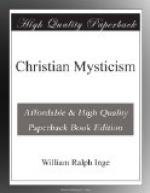so persistently the charge that Christ borrowed from
Plato what was true in His teaching, that Ambrose
wrote a treatise to confute them. As a rule,
the Christians did not deny the resemblance, but explained
it by saying that Plato had plagiarised from Moses—a
curious notion which we find first in Philo.
In the Middle Ages the mystics almost canonised Plato:
Eckhart speaks of him, quaintly enough, as “the
great priest” (der grosse Pfaffe); and
even in Spain, Louis of Granada calls him “divine,”
and finds in him “the most excellent parts of
Christian wisdom.” Lastly, in the seventeenth
century the English Platonists avowed their intention
of bringing back the Church to “her old loving
nurse the Platonic philosophy.” These English
Platonists knew what they were talking of; but for
the mediaeval mystics Platonism meant the philosophy
of Plotinus adapted by Augustine, or that of Proclus
adapted by Dionysius, or the curious blend of Platonic,
Aristotelian, and Jewish philosophy which filtered
through into the Church by means of the Arabs.
Still, there was justice underlying this superficial
ignorance. Plato is, after all, the father of
European Mysticism.[109] Both the great types of mystics
may appeal to him—those who try to rise
through the visible to the invisible, through Nature
to God, who find in earthly beauty the truest symbol
of the heavenly, and in the imagination—the
image-making faculty—a raft whereon we
may navigate the shoreless ocean of the Infinite; and
those who distrust all sensuous representations as
tending “to nourish appetites which we ought
to starve,” who look upon this earth as a place
of banishment, upon material things as a veil which
hides God’s face from us, and who bid us “flee
away from hence as quickly as may be,” to seek
“yonder,” in the realm of the ideas, the
heart’s true home. Both may find in the
real Plato much congenial teaching—that
the highest good is the greatest likeness to God—that
the greatest happiness is the vision of God—that
we should seek holiness not for the sake of external
reward, but because it is the health of the soul,
while vice is its disease—that goodness
is unity and harmony, while evil is discord and disintegration—that
it is our duty and happiness to rise above the visible
and transitory to the invisible and permanent.
It may also be a pleasure to some to trace the fortunes
of the positive and negative elements in Plato’s
teaching—of the humanist and the ascetic
who dwelt together in that large mind; to observe
how the world-renouncing element had to grow at the
expense of the other, until full justice had been
done to its claims; and then how the brighter, more
truly Hellenic side was able to assert itself under
due safeguards, as a precious thing dearly purchased,
a treasure reserved for the pure and humble, and still
only to be tasted carefully, with reverence and godly
fear. There is, of course, no necessity for connecting
this development with the name of Plato. The




